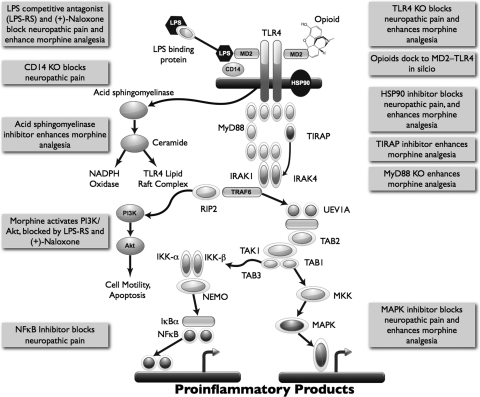Fig. 1.
TLR4 signaling cascade and evidence for modulation by neuropathic pain and opioids. TLR4 signaling occurs via a cascade of events. The classic TLR4 ligand is Gram-negative bacterial LPS (hexagon), which is transported to the cell via LPS-binding protein and transfers LPS to CD14 on the cell membrane. This leads to intracellular activation of acid sphingomyelinase, which generates ceramide. Ceramide induces the generation of a lipid raft containing the coreceptor MD2, TLR4, and the 70- and 90-kDa heat shock proteins (HSP), among other elements. Ceramide also activates NADPH oxidase, which leads to peroxynitrite formation. CD14 transfers LPS to MD2, leading to both MD2-TLR4 heterodimerization and then homodimerization of MD2-TLR4 pairs. Recent evidence also suggests that opioids, such as morphine, can interact with MD2, causing a similar activation of a functional TLR4 signaling unit. Ensuing intracellular signaling occurs through toll-interleukin 1 receptor domain containing adaptor protein (TIRAP) to at least three parallel pathways: cell motility and cell survival/apoptosis occur through the phosphatidylinositol 3-kinase (PI3K)/Akt pathway, and proinflammatory products such as cytokines result from activation of the NF-κB and MAPK pathways. The gray boxes provide summaries of the converging evidence that neuropathic pain and opioids interact with the TLR4 signaling cascade. IRAK, IL-1-receptor-associated kinase; UEV1A, ubiquitin-conjugating enzyme E2 variant 1A; RIP2, receptor-interacting protein 2; TAK1, transforming growth factor-β-activated kinase-1; TAB3, transforming growth factor-β-activated kinase 1/MAP3K7 binding protein 3; MKK, MAP kinase kinase; IKK, IκB kinase complex; IκBα, inhibitor of nuclear factor-κB α; NEMO, NF-κB essential modifier. [Adapted from Watkins LR, Hutchinson MR, Rice KC, and Maier SF (2009) The “toll” of opioid-induced glial activation: improving the clinical efficacy of opioids by targeting glia. Trends Pharmacol Sci 30:581–591. Copyright © 2009 Elsevier Science. Used with permission.]

